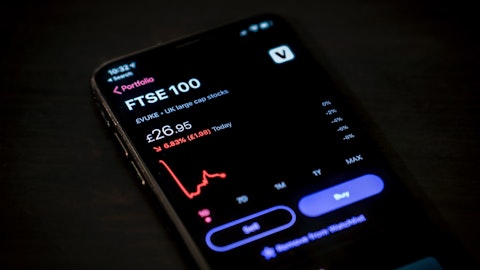Conn’s, Inc. (NASDAQ:CONN) Q4 2024 Earnings Call Transcript April 11, 2024
Conn’s, Inc. beats earnings expectations. Reported EPS is $-1.25, expectations were $-1.57. Conn’s, Inc. isn’t one of the 30 most popular stocks among hedge funds at the end of the third quarter (see the details here).
Operator: Good morning and thank you for holding. Welcome to Conn’s, Inc. Conference Call to discuss Earnings for the Fiscal Quarter and Year Ended January 31, 2024. My name is Doug and I’ll be your operator today. During the presentation, all participants will be in a listen-only mode. After the speakers’ remarks, you’ll be invited to participate in the question-and-answer session. As a reminder, this conference call is being recorded. The company’s earnings release, dated April 11, 2024 was distributed this morning and is accessed via the company’s investor relations website at ir.conns.com. During today’s call, management will discuss, among other financial performance measures, adjusted net income, adjusted retail segment operating loss, and adjusted credit segment operating income.
Please refer to the company’s earnings release that was issued today for reconciliation of these non-GAAP measures to their most comparable GAAP measures. I must remind you that some of the statements made in the call are forward-looking statements within the meaning of the federal securities laws. These forward-looking statements represent the company’s present expectations or beliefs concerning future events. The company cautions that such statements are necessarily based on certain assumptions which are subject to risks and uncertainties, which could cause actual results to differ materially from those indicated above. Your statements today are Norm Miller, the company’s CEO, and Tim Santo, the company’s CFO. I would now like to turn the conference call over to Mr. Miller.
Please go ahead.
Norm Miller : Good morning and thank you for joining today’s call to review the progress we’re making combining W.S. Badcock and Conn’s and our fourth quarter and fiscal year 2024 financial results. I am excited to provide an update on the integration between Badcock and Conn’s, as well as the progress we are making executing against several near-term strategic priorities that we believe will position the company for year-over-year improvements in retail sales and profitability. As a reminder, on December 18, 2023, we announced and closed a transformative transaction with Badcock. By uniting the two companies, each with over 120 years of serving customers, we have created a leading home goods retailer with more than 550 retail locations across 15 states in the southern United States.
Once fully integrated, we believe the transaction will accelerate our growth by combining two complementary businesses with similar product categories, payment solutions, and customer profiles, while driving material cost savings, enhancing gross margins, and improving operating leverage. Over the past three plus months, the combined leadership team is focused on integrating the two organizations, aligning around a common culture, and establishing a platform to drive significant revenue and cost synergies in the coming quarters. Our cross-functional teams are working with strong momentum to quickly improve our performance and create lasting value for our customers, employees, dealers, communities, and shareholders. As a result, we have identified five near-term strategic priorities that include transitioning Badcock’s credit program to Conn’s in-house loan product, optimizing our merchandising strategy, fully integrating our combined supply chain, leveraging Conn’s e-commerce capabilities, and finally realizing significant cost synergies.
So with this overview, let’s look at the strategic priorities in more detail, starting with efforts to transition Badcock to Conn’s credit program. As I mentioned on our last call, Badcock currently provides an in-house revolving credit program to its customers and last year approximately 60% of their sales were financed using this offering. By its nature, revolving credit products provide consumers with higher monthly payments, lower availability, and shorter durations compared to Conn’s installment loan product. For example, Badcock’s average ticket last year was approximately $1,400, which in the state of Florida equates to a monthly payment of approximately $110. By comparison, this same $1,400 purchase in Florida would have a monthly payment of approximately $56 under Conn’s in-house installment loan.
As you can see, at the same average ticket, Badcock’s monthly payment is nearly twice as much as Conn’s. We have stated historically that our core customer makes the purchasing decision primarily based on the amount of their monthly payment. As you can see from this example, and with similar product categories and customer profiles, we believe we can significantly increase Badcock’s average ticket. In fact, Conn’s went through a similar multi-year transition and had an average ticket of under $1,600 when I first joined the company in September 2015, compared to an average ticket of over $1,800 today. This successful transition supports a high degree of confidence that we can provide more purchasing opportunities for Badcock’s customers. As a result, we believe credit-driven growth strategies will be an important near-term catalyst to unlock revenue and cost synergies in the coming quarters.
With much of the work already underway, we have launched Conn’s credit in select Badcock stores here in the month of April with the expectation of offering Conn’s credit across all Badcock locations by the end of May. We are also pursuing additional credit-driven opportunities to capture more customers. First, we will focus on leveraging Conn’s pre-qualified direct mail and credit-based marketing expertise to drive sales at Badcock. Most recently, Badcock has focused on a product-based marketing strategy, while over the years, Conn’s has utilized credit-based marketing channels and messaging to promote our multiple payment options. Given our similar geographies, customer profiles, and product categories, we believe we can quickly leverage Conn’s credit-based marketing experience to better promote the payment options of the combined company.
Second, we plan to implement the innovative digital application process we successfully launched last year. This will make it easier for Badcock’s customers to apply for the multiple payment options we provide, while limiting the impact a credit application has on a customer’s credit score. The enhancements we made to our application process over the past year had a powerful impact at Conn’s, as our application volume increased 21.6% year-over-year. Third, we also believe the transition from Badcock’s in-house revolving credit product to Conn’s in-house installment loan, will enhance the yield on Badcock’s portfolio. Before we even consider expected increases in Badcock’s sales, we believe the transition to Conn’s in-house installment loan will contribute nearly $20 million in incremental finance charges and other revenue once the portfolio is fully seasoned.
While the yield will be higher, we expect our customers to benefit from a lower monthly payment and greater purchasing power, similar to Conn’s successful transition from a retail installment contract to a direct loan structure back in 2016. Finally, we expect Badcock to benefit from Conn’s 10 plus years of experience offering lease-to-own payment plans to our customers. While Badcock has historically offered third-party lease-to-own plans, it represented only about 3% of sales last year compared to over 9% of Conn’s fourth quarter retail sales, which was the highest quarterly level at Conn’s, since I rejoined the company as CEO in October 2022. Lease-to-own growth at Conn’s reflects the success of our efforts to refocus on our core credit constrained customers.
Given Badcock’s similar product categories, customer profiles, and store locations, we believe there are material opportunities to drive lease-to-own sales at Badcock. It’s important to note that over the past eight years, Conn’s has developed a best-in-class credit infrastructure with a team of highly experienced leaders, supporting sophisticated underwriting, servicing, collections and recovery capabilities. We expect our credit-driven strategies will quickly contribute to sales growth in the coming quarters, and I look forward to updating investors on the success of our rollout on future calls. Optimizing our merchandising strategy is the next priority I want to review today. Badcock was founded as a furniture and mattress retailer, expanding its product categories over the years to include appliances, consumer electronics, and home office, with furniture and mattress sales representing 70% of Badcock’s annual sales prior to the transaction.
Conversely, Conn’s was founded as an appliance retailer, expanding our product categories over the years to include consumer electronics, furniture, mattress, and home office with appliance, electronics, and computers representing nearly 60% of Conn’s product sales prior to the transaction. We believe this complementary sales mix creates opportunities to drive appliance, consumer electronics, and home office sales at Badcock while supporting greater furniture and mattress sales at Conn’s. As we look at Badcock and Conn’s assortment, approximately 95% of our product categories overlap, but we only share 45% of the same vendors. As we align our assortment across our combined product categories, we are focusing on capitalizing on the best-selling products at both Conn’s and Badcock.
We will also take advantage of material, margin, and cost opportunities as we consolidate vendors, benefit from our larger scale, and leverage the success of both Conn’s and Badcock’s private-label platforms. We have already started to realize the initial benefits of transitioning Badcock’s expertise in higher margin furniture and mattress categories to Conn’s, combining our assortments, and optimizing our merchandising strategy. As we work through our existing inventory over the next 12 months to 18 months and further strengthen our assortment, we expect to benefit from additional opportunities to drive sales growth and expand margins over the coming year. We will also benefit from Badcock’s higher percentage of furniture and mattress sales.
With just six weeks of Badcock’s retail sales, our consolidated retail gross margin in the fourth quarter was 38.3% compared to 33.5% in the quarter prior to the transaction, representing a 480 basis point increase. The contribution of Badcock was the primary driver of our gross margin improvement from the third quarter. As our integration efforts continue, we expect our retail gross margin to improve to over 40% in the coming quarters. The next strategic priority I will review today are the enhancements we are making to integrate our supply chains and transition Badcock to Conn’s last-mile delivery and service capabilities. In fact, efforts to integrate our supply chain are already underway. Recently, we started the process to consolidate regional distribution centers in Florida, Georgia, and North Carolina where Conn’s and Badcock overlap.
We have also started to leverage Badcock’s international freight capabilities and expertise, which we believe will improve our cost per container by approximately $1,000 going forward. Transitioning Badcock’s delivery and service capabilities to Conn’s best-in-class platform is another important component of our integration plan. Last year, Conn’s provided last-mile delivery services to approximately 74% of our retail sales. In addition, 95% of appliance and TV repairs are performed by Conn’s employees, and our repair time is 50% faster than the industry average. On the other hand, Badcock’s delivery and service model is decentralized and differs by location. By transitioning to Conn’s centralized platform, we believe we can improve Badcock’s customer experience and leverage our existing delivery infrastructure.

In addition, since we operate in the same states, we can quickly transition Badcock’s last-mile delivery and service capabilities to Conn’s, while also driving efficiencies. We expect these efforts to provide another opportunity to expand our retail gross margin in the coming quarters. Turning to our e-commerce integration strategies, for the year ending January 31, 2024, Conn’s had record e-commerce sales of $109.3 million, representing a 38.2% increase from last fiscal year and nearly a nine-fold improvement from the $12.6 million in e-commerce sales we achieved just four years ago. Badcock’s e-commerce sales were $22.4 million this past year, reflecting a 27% year-over-year decline. From a balance of sales standpoint, e-commerce represented 11.1% of Conn’s total retail sales last year compared to 4.6% at Badcock.
By leveraging Conn’s established digital resources and capabilities we are confident we can improve Badcock’s e-commerce sales and begin a multi-year process to align Badcock with Conn’s growing balance of e-commerce sales. Initially, we expect to improve Badcock’s performance through the actions underway to optimize our product assortment and transition Badcock to Conn’s last-mile delivery and service model. During the year, we will begin leveraging Conn’s digital marketing capabilities, which includes our recently launched application process and the investments we have made across our digital platform to further support the e-commerce growth strategies of the combined company. As a result, we continue to believe we can grow e-commerce sales to well over $300 million in the next several years.
The final strategic priority I want to review today are the actions we are pursuing to realize significant cost savings and quickly expand profitability. I am pleased to report that we are ahead of plan and during the fourth quarter alone, we removed approximately $50 million of combined annualized expenses in the form of headcount reductions, optimizing vendor agreements, and eliminating other operating costs. We have identified an additional $50 million of cost that we expect to remove from the combined business over the next 18 months. Looking at our quarter-to-date sales, as of today’s call, overall sales are up approximately 40.7% year-over-year, as a result of the contribution of Badcock. Quarter-to-date same-store sales for the combined business are down approximately 13.5%.
As the year progresses, we expect to see an inflection in same-store sales performance as we benefit from the integration and growth strategies we have outlined today. We also expect market trends for the home related products we sell to improve in the back half of the year. In addition, we continue to focus on supporting our customers and driving retail sales, while prudently managing credit risk as our core customers feel the ongoing effects of higher inflation driven by increased housing costs and card expenses. We believe our sophisticated in-house credit underwriting and collection capabilities, combined with our industry leading payment options, provide the company with a significant advantage over other retailers. Despite a fluid operating environment, we believe fiscal 2025 will be a transformative year for Conn’s.
The Badcock transaction has exceeded our initial expectations. We have quickly identified powerful operating and financial synergies and created a growth-focused integration plan that we are now executing against. While there will be continued one-time costs that will impact our results in the first quarter, we believe our shareholders will begin to see the benefits of our new operating model in the second quarter and we expect to produce accelerating revenue and earnings growth through this year. I want to reiterate my optimism for our path going forward. Over the coming quarters, I am confident we will start to benefit from the powerful financial model we are creating, which is supported by our premium shopping experience, best-in-class payment offerings, leading e-commerce capabilities, and unique dealer network.
In addition, we expect our larger scale will improve purchasing and logistics expenses, while also driving opportunities to leverage fixed costs. We expect to benefit from more than $100 million of annualized cost synergies, as well as over $50 million of revenue synergies over the next 18 months. As positive momentum in our business builds, we continue to believe that we can achieve annual adjusted EBITDA of between $180 million to $220 million on total annual sales between $2 billion to $2.2 billion by the end of our next fiscal year. I believe strongly we have the right strategies, leadership team, associates, dealers, and platform in place to deliver on the goals we have outlined today. Together, we will have an even greater impact on the communities we serve, and I am excited by the opportunities we have in front of us to produce long-term value for our stakeholders.
I would like to take this opportunity as well to acknowledge Tim Santo, who has recently appointed Conn’s permanent CFO. Tim, on behalf of everyone at Conn’s, congratulations on your promotion. Now I’ll turn the call over to Tim to review our financial results in more detail.
Tim Santo : Thank you Norm. I am pleased to join everyone on this morning’s call and excited by the near-term strategies we are pursuing to quickly integrate Badcock and produce improving sales and profitability in the coming quarters. I look forward to updating investors on the progress we are making on future calls. Our fourth quarter financial performance reflects ongoing industry headwinds, as well as one-time costs primarily associated with the completion of the Badcock transaction on December 18th, 2023. In addition, it is important to note that our fourth quarter results include approximately six weeks of Badcock’s performance and Badcock’s financial results will be consolidated in our quarterly results going forward.
On a consolidated basis, total revenues were $366.1 million for the fourth quarter, representing a 9.3% year-over-year increase. For the fourth quarter, the company reported GAAP net income of $43.3 million, compared to a GAAP net loss of $42.8 million for the same period in fiscal year 2023. GAAP net income includes a one-time bargain purchase gain of $104.9 million, transaction costs of $16.3 million, and a one-time loss on extinguishment of debt of $14.2 million. Reconciliations of GAAP to non-GAAP financial measures are available in our fourth quarter earnings press release that was issued this morning. On an adjusted basis, we reported a net loss of $31 million for the fourth quarter compared to a net loss of $36.7 million in that same period last fiscal year.
Looking at the performance of our retail segment in more detail. Total retail revenues were $296.9 million in the fourth quarter. The 9.6% year-over-year increase in retail revenue was primarily driven by Badcock revenue of $60.3 million, offset by a 14.4% decrease in same store sales. Same store sales during the fourth quarter were impacted by lower discretionary spending for home-related products, following an extended period of excess consumer liquidity, which resulted in accelerated sales. For the fourth quarter, retail segment operating loss was $38.1 million, compared to a retail segment operating loss of $19.5 million for the same period in fiscal year 2023. On a non-GAAP basis, adjusted retail segment operating loss for the fourth quarter was $21.8 million compared to a loss of $11.7 million for the same period last year, reflecting a decrease in same-store sales and higher SG&A costs, partially offset by improved retail gross margin.
Turning to our credit segment, fourth quarter credit revenues increased 10.4% year-over-year to $70.8 million, primarily due to the addition of Badcock’s receivables, partially offset by a decline in the average balance of the Conn’s consumer receivable portfolio. Overall credit trends remain stable, reflecting prudent underwriting strategies aimed at controlling risk during a more uncertain economic period. As a percent of the portfolio, the 60-day delinquency balance was 12.2% at January 31, 2024, compared to 12.7% last fiscal year. The balance of re-aged accounts, as a percent of the portfolio was 18.8% compared to 16.5% for the same period in fiscal year 2023. Both 60-day delinquencies and re-aged balances remain well below pre-COVID levels, while we have also experienced a significant increase in the weighted average credit score of finance sales.
In fact, our 60-day delinquency balance has improved by 30 basis points, and the re-age balance has improved 10.6 percentage points since January 31, 2020. For the fourth quarter of fiscal year 2024, net charge-offs as a percent of the average portfolio balance were 15.9% compared to 17.1% for the same period last fiscal year. The company reported a credit segment loss before taxes of $53.1 million in the fourth quarter compared to a credit segment loss of $27 million for the same period last fiscal year. On a non-GAAP basis, adjusted credit segment operating income for the fourth quarter was $1.4 million compared to an operating loss of $13.9 million for the same period last year. Reflecting higher credit segment revenue partially offset by an increase in our provision for bad debt.
Our credit spread was 7.5% at January 31, 2024 compared to 9.1% last fiscal year. Looking at our balance sheet and capital position in more detail, on January 26, 2024, we completed a $252.6 million ABS transaction with the Class A bond 13 times oversubscribed and the Class B bond 9 times oversubscribed, which reflects the strong performance of our customer receivables. We anticipate completing two to three additional ABS transactions this year as a result of higher expected sales levels. At January 31, 2024, we had $155.3 million of available borrowing capacity under our $555 million revolving credit facility. In addition, we had $50 million of borrowing capacity available under the delayed draw term loan, resulting in total available borrowing capacity of $205.3 million.
As we look forward towards the future, we are excited by the direction Conn’s is headed. There will be continued one-time costs that impact our results in the first quarter, but we expect to see the benefits of our new operating model starting in the second quarter. In addition, we expect to benefit from more than $100 million of annualized cost synergies as well as over $50 million of revenue synergies over the next 18 months. As this positive momentum builds, we expect to generate annual adjusted EBITDA of between $180 million to $220 million on total annual sales of between $2 billion to $2.2 billion by the end of our next fiscal year. Finally, I want to share my thanks to all our team members for their continued hard work, service, and dedication.
So with this overview, Norm and I are happy to take your questions. Operator, please open the call to questions.
See also 12 Ridiculously Cheap Stocks to Buy Now and Hold for the Long Term and 15 Most Populated Cities in South America.
Q&A Session
Follow Conns Inc (NASDAQ:CONN)
Follow Conns Inc (NASDAQ:CONN)
Operator: Thank you. Ladies and gentlemen, at this time we will be conducting a question-and-answer session. [Operator Instructions] Our first question comes from the line of Derek Sommers with Jefferies. Please proceed with your question.
Derek Sommers: Hi, good morning, everyone. Can you talk about your expectations for store count at both Conn’s and Badcock in the near-term?
Norm Miller: Yeah, Derek, I appreciate the question. What I would say is, in the near-term, don’t expect any variance from the 550 stores we currently have longer-term, my expectations would be some of the overlap specifically in the Florida market where we’re — Conn’s is relatively new in that market and we’ve got about 20 stores there. And there is some overlap in that market in North Carolina. There could be some consolidation, but I wouldn’t expect that to happen probably until next fiscal year.
Derek Sommers: Okay, got it. And then on the gross margin expansion in this quarter, can you go into more detail on some of the drivers behind that? How much was attributable just to product mix shift? And were there any other drivers behind the expansion?
Norm Miller: Yeah, very excited about what’s happening from a gross margin standpoint with the business. As I mentioned in my prepared comments, the product mix shift is a significant portion of it. That’s probably 80% of it. Both product mix shift on the Conn’s side and bringing the Badcock higher mix of furniture and mattress into the overall combined business is the primary driver of driving the higher margin. We are seeing improvement from a freight cost standpoint on both sides of the business, which is being helpful as well. So very bullish on the gross margin standpoint. The retail margin we would expect, as I said in my comments, that to continue to see upside there and that margin to be over 40% on a consistent basis here, as we go through the rest of this year and going forward into the future.
Derek Sommers: Got it. Thank you. That’s very helpful. And then on credit applications for the quarter, kind of year-over-year growth is moderating a bit, but the mix of sales finance continues to grow, which seems a little counterintuitive. Is there — can you provide any commentary on what’s driving that dynamic or any other color behind it?
Norm Miller: Sure. Part of the reason that it is — you’re seeing some moderation in growth is we’re starting to lapse some of the increases, the dramatic increases we saw in application growth a year ago. But the reason you were still seeing growth is, we’re seeing average ticket increase, and we’re also seeing better usage. So it’s not just a number of applications. It’s how many applications are approved and ultimately used. And as we get better and more efficient at targeting the right customers that are going to ultimately be able to use the application and we’re getting more effective in that — from that front, it actually is enabling us to still drive Conn’s financing and LTO financing growth year-over-year.
Derek Sommers: Got it. And then on the timeline for integrating Badcock onto kind of Conn’s financing platform is there any kind of — will corporate stores from Badcock have more or less access to financing products in franchisee stores? Or is there any kind of differentiation there on the store mix?
Norm Miller: No, there really isn’t a differentiation. Currently, there is that within the Badcock stores, they’re currently offering a third-party financing in the corporate stores. But they are still doing Badcock financing and they have in their stores. But as we said, their in-house financing is not nearly as sophisticated from an underwriting standpoint, as well as the product itself is very different with the installment loan versus the revolving credit. As we roll out and as I said in my comments, that is already underway. We are already in a number of both corporate stores and dealer stores with the Conn’s in-house finance product. And it will be the same across ultimately all approximately 380 stores. Remember, even with the dealers, we control — when I say we — the company controls the underwriting, they control the entire credit infrastructure.
Who gets lent credit? How much credit, the collection process, it will be the same for both dealer stores and corporate stores, all controlled by our credit infrastructure system, which has proven itself to be very successful over the last six years or seven years.
Tim Santo: I may add to the comment, as Norm mentioned, we are already starting the process of implementing where the corporate stores did not have the legacy Badcock credit platform. We are already seeing a sizable lift in sales in those corporate stores. So we are expecting some very strong results.
Derek Sommers: Got it. That’s helpful. And then last one for me, just any commentary on tax refund season so far. Any noticeable changes in retail sales activity from that or portfolio collection?
Norm Miller: Yeah, I guess having lived through eight or nine of these tax seasons, what I would say is post-COVID — this tax season as — from a collection standpoint, pretty pleased with where this is shaking out. It’s been very solid for us, very similar to last year for us. On the Conn’s side, it’s very, very solid tax season. What I will say is on the retail side, since COVID, we did see an uptick but not nearly to the degree that we had seen previous to the pandemic in COVID. There used to be a larger increase from a retail standpoint, when tax season kicked off and during tax season. My conclusion to that is that both from a pull forward of demand, and with the product categories that we carry and the state of the consumer right now, there’s – and it’s not quite as robust in the high ticket items within the home has probably — the consumer has used those funds for other things to a greater degree than they did probably pre-pandemic in our categories.
Derek Sommers: All right, great. That’s all for me. Thank you for taking my question.
Norm Miller: Thanks, Derek. Appreciate it.
Operator: There are no further questions in the queue. I’d like to hand the call back to management for closing remarks.
Norm Miller: Thank you. Just want to take a moment and express my appreciation to all of our employees across both the Conn’s organization and the Badcock organization for their hard work, their contributions, their dedication over the past three months or four months, as we are working hard to combine the two businesses, truly remarkable what they’re doing and it’s very much appreciated. We also appreciate your interest in the company for those on the call and listening to the call and look forward and excited to share our results and performance in the first quarter as this integration continues. Have a great day.
Operator: Ladies and gentlemen, this does conclude today’s teleconference. Thank you for your participation. You may disconnect your lines at this time and have a wonderful day.




